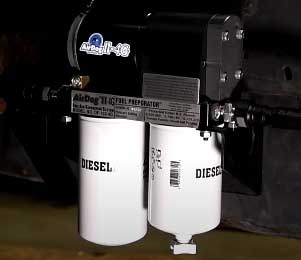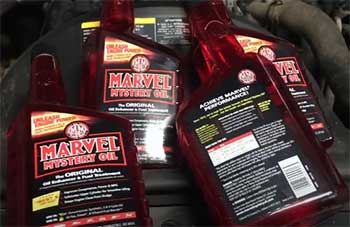The diesel performance world is chock full of options and alternatives when it comes to fuel delivery systems. In this article, we’re pitting two giants of the industry against each other: FASS Fuel Systems and the AirDog 6.0 Powerstroke.
Both of these systems are renowned for their performance-enhancing features, but the question is: which one reigns supreme?
A Brief Comparison Table
| Aspect | FASS Fuel Systems | AirDog 6.0 Powerstroke |
| Installation | Complex and time-consuming | Relatively easy and straightforward |
| Performance | Enhanced HP, torque, and throttle response | Can handle high HP (up to 800) |
| Fuel Efficiency | Increased fuel economy | Similar increase in fuel efficiency |
| Quality | Known for durability | Some users report reliability concerns |
| Noise Level | Can be a bit noisy | Generally quieter |
| Cost | Generally more affordable | Usually more expensive |
FASS Fuel Systems: The Power Booster

FASS, or Fuel Air Separation System, is a popular choice among diesel owners.
This system separates air, water, and fuel contaminants, ensuring a clean, pure fuel supply to your engine.
FASS is designed to boost horsepower (HP), enhance engine performance, and improve fuel economy.
But let’s delve deeper into the pros and cons of using a FASS Fuel System.
The Pros of FASS Fuel System
- Performance enhancement: FASS promises a significant increase in HP, torque, and throttle response. This is because the system efficiently separates air and vapor from the fuel, providing a steady, clean fuel supply that leads to better combustion.
- Fuel efficiency: By supplying a consistent flow of clean fuel, FASS systems reduce the need for your engine to work hard to filter out contaminants. This, in turn, improves fuel economy and engine longevity.
- Quality and Durability: FASS systems are known for their robust construction and long-lasting performance. They are built to withstand even the harshest conditions.
The Cons of FASS Fuel System
- Installation complexity: One downside to FASS is the complexity of installation. The process can be time-consuming and requires mechanical knowledge.
- Noise level: FASS systems can be a bit noisy. While this might not be an issue for everyone, some users may find the hum to be a nuisance.
AirDog 6.0 Powerstroke: The High-Flier

AirDog 6.0 Powerstroke is another noteworthy competitor in the diesel fuel system market.
It’s designed to improve fuel efficiency, performance, and the longevity of injectors.
But how does it stack up against FASS?
Let’s explore the advantages and disadvantages of AirDog 6.0 Powerstroke.
The Pros of AirDog 6.0 Powerstroke
- HP handling: The AirDog 6.0 Powerstroke can handle high levels of horsepower. In fact, the AirDog 165 model can handle up to 800 HP, making it suitable for heavy-duty applications.
- Ease of installation: Unlike the FASS system, the AirDog 6.0 Powerstroke is relatively easy to install. This is a big plus for users who aren’t comfortable handling complex installations.
- Performance enhancement: Just like FASS, AirDog 6.0 Powerstroke enhances performance by ensuring a clean, steady flow of fuel to your engine.
The Cons of AirDog 6.0 Powerstroke
- Cost: The AirDog 6.0 Powerstroke is relatively more expensive than the FASS system. This might not be a deal-breaker for some, but for others, it might be a significant consideration.
- Reliability concerns: While generally reliable, some users have reported reliability issues with AirDog 6.0 Powerstroke. These range from occasional system failures to problems with customer service.
Key Differences Between FASS and AirDog 6.0 Powerstroke
Although both FASS and AirDog 6.0 Powerstroke have earned high praises from diesel owners, they have a few critical differences that set them apart. Understanding these differences is key to making an informed decision on the fuel system that is perfect for your needs.
- Installation Process
One of the most apparent differences between the FASS and AirDog 6.0 Powerstroke is the installation process. While both systems are designed for aftermarket installation, they differ significantly in terms of installation complexity.
FASS Fuel Systems are known for their comprehensive design, which can be a double-edged sword. This means a thorough installation process that can be time-consuming and may require advanced mechanical knowledge.
This complexity ensures a seamless fit and optimal performance but may not be ideal for individuals who are not particularly handy or those who want a quick installation process.
On the other hand, AirDog 6.0 Powerstroke takes pride in its user-friendly installation process. The system is designed to be installed with relative ease and fewer complexities than its FASS counterpart. This makes AirDog a more attractive option for users who prioritize convenience in installation.
- Performance Enhancement
Both FASS and AirDog 6.0 Powerstroke aim to boost engine performance, but they differ in how they achieve this.
FASS systems focus on purifying the fuel before it reaches the engine. It separates air, water, and fuel contaminants, ensuring a clean and pure fuel supply to your engine.
The result is an increase in horsepower, enhanced throttle response, and improved fuel economy.
AirDog 6.0 Powerstroke, however, places a strong emphasis on high horsepower handling. The AirDog 165, for instance, can handle up to 800 HP, making it an ideal choice for heavy-duty applications and high-performance requirements.
- Price and Reliability
Another key difference between these two systems lies in their price points and reliability. While both systems offer high-quality performance, there are some differences to note.
AirDog 6.0 Powerstroke is generally more expensive than the FASS system. The higher price point is justified by its ease of installation and ability to handle high horsepower levels.
However, some users have reported reliability concerns, including occasional system failures and issues with customer service.
FASS systems, while being a bit more affordable, are renowned for their durability and reliability. They are built to last, offering consistent performance even in the harshest conditions.
However, the noise level of the FASS systems can be a bit higher, which might be a concern for some users.
Also Read: The Tale of FASS Fuel System.
Frequently Asked Questions (FAQ)
An AirDog 165 can handle up to 800 HP, making it a robust choice for high-powered, high-performance applications.
Yes, a FASS Fuel System does add HP. By removing air and contaminants from the fuel, FASS allows for better combustion, leading to an increase in horsepower.
FASS Fuel Systems offer several advantages. They improve performance by increasing horsepower and torque. They also enhance fuel economy by reducing the workload on your engine. Lastly, FASS systems are known for their quality and durability, promising long-lasting performance.
Yes, a 6.0 Powerstroke engine does have a high-pressure fuel pump. This pump is designed to deliver fuel to the injectors at high pressure, which is crucial for the engine’s efficient operation.
Conclusion
When deciding between FASS and AirDog 6.0 Powerstroke, your choice will ultimately depend on your specific needs and preferences. Both systems offer unique advantages, so take time to evaluate which features are most important for you.
Whether it’s FASS’s robust performance or AirDog’s ease of installation, make sure to choose the system that best suits your vehicle and driving needs.
Remember, a well-functioning fuel delivery system is essential for your engine’s performance, fuel economy, and longevity. So, make an informed decision and give your engine the fueling power it deserves.


